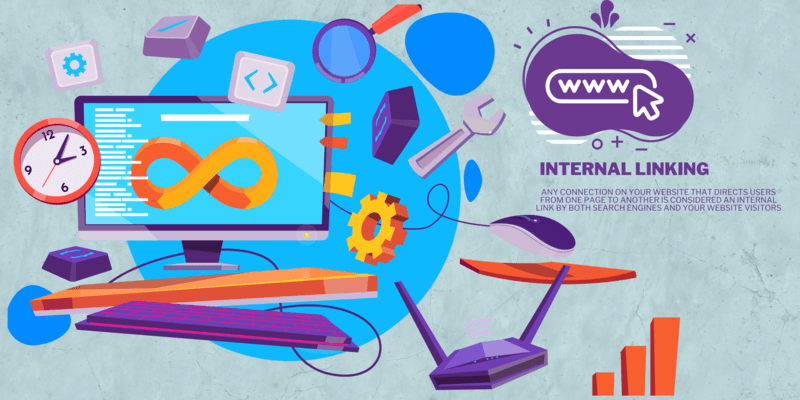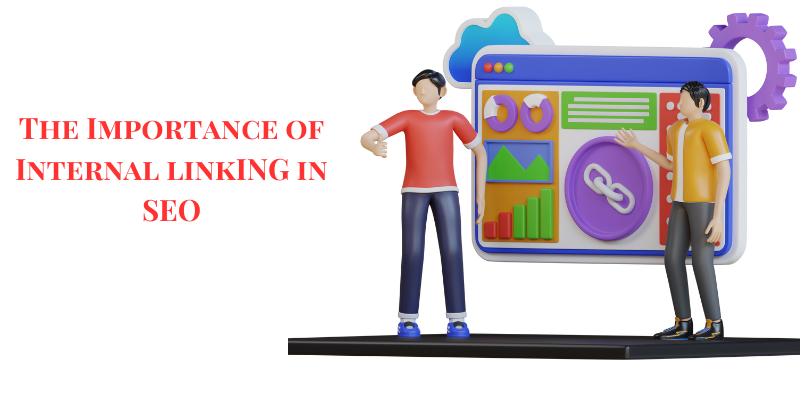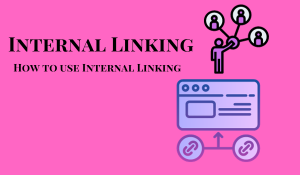Internal Linking for SEO – BEST Practices and Tips
Updated: February 19, 2024
90
What is Internal linking?
Internal linking is a crucial element of search engine optimization (SEO) that deserves careful attention. It involves creating hyperlinks that connect one page to another within a website.
External Links
External links, on the other hand, refer to links from other websites that point to pages on our site.
Backlinks
Backlinks are inbound links, and they involve adding our website’s links to other websites to enhance our SEO performance and increase website traffic.
How to add an Internal Link in WordPress?

Any connection on your website that directs users from one page to another is considered an internal link by both search engines and your website visitors. It helps users search your website and find the content they want.
They also play a crucial role in how search engines crawl and index. If a page has no internal links, it may go unnoticed by search engines.
However, it can boost your website’s rankings and improve the user experience.
In this blog, we will dig into the world of internal linking and explore how to apply it to improve our SEO strategy.
Whether you are a beginner or an experienced SEO expert, this guide will provide valuable insights and techniques to make the most of internal linking for your website.
Let’s unlock the potential of internal linking and take your SEO game to the next level.
Understanding the Concept of Internal Linking in SEO
It is a major concept in search engine optimization (SEO).
Definition
It refers to connecting different pages within your website using hyperlinks. these links help search engines understand the arrangement and ranking of your specific site, making it easy for Google to rank your content.
When done correctly, they can have a significant impact on your SEO efforts. It helps to distribute link authority throughout your website and boost the visibility and rankings of essential pages.
Additionally, internal links provide seamless navigation skills for users, allowing them to quickly negotiate between related content and discover more information on your site.
Understanding the concept of internal linking is essential for any website owner or SEO practitioner. It involves strategically placing links throughout your site, ensuring they are relevant and contextually appropriate.
Must Read: What is the full form of URL
The Importance of Internal Linking in SEO

Internal linking is not just a nice-to-have element in SEO; it is a crucial aspect that can make or break your website’s rankings.
Why interlink your pages?
| When implemented efficiently, internal linking can benefit your SEO strategy |
|---|
|
Furthermore, internal linking aids search engines in understanding the structure and hierarchy of your site. It helps search engine crawlers effectively crawl and index your content, ensuring that all your valuable pages are recognized and displayed in search results.
Efficient internal linking is crucial for improving your website’s rankings, enhancing the user experience, and ensuring that search engines discover your valuable content. By incorporating this strategy into your SEO efforts, you can unlock the full potential of internal linking and boost your website to new heights.
Understanding Internal linking
To optimize for better SEO, there are several practical strategies you can apply.
- Firstly, focusing on creating a logical site structure with a clear hierarchy involves organizing your content into categories and subcategories and linking pages together based on their relevance and importance.
- Next, incorporating keyword-rich anchor text in your internal links helps search engines understand the context and relevance of the linked pages.
- Do not use anchor text like “click here” and instead use descriptive phrases that accurately reflect the content of the linked page.
- Additionally, consider using breadcrumbs as a form of internal linking. Breadcrumbs provides a straightforward way for users to navigate through your website.
Furthermore, regularly conduct internal link audits to identify broken or outdated links. Fix or remove these links to ensure a seamless user experience and to maintain a healthy link profile.
Lastly, leverage related content and create internal linking opportunities within your articles and blog posts. Linking to relevant articles or related topics helps to provide additional value to your readers and encourages them to explore more of your content.
By implementing these practical strategies, you can optimize your internal linking for better SEO and improve the visibility and rankings of your website.
| Mistakes to Avoid in Internal Linking |
|---|
|
It can be a powerful tool in SEO, but it’s essential to avoid inevitable mistakes that can undermine its effectiveness. One common mistake is using too many internal links on a single page. While it’s essential to interlink your pages, overdoing it can make your content look spammy and confusing for users. Another mistake is using irrelevant anchor text. Your anchor text should accurately describe the linked page, helping search engines and users understand its content. Additionally, use a different anchor text for multiple internal links, as this can dilute the effectiveness of your linking strategy. Finally, neglecting to audit your internal links regularly can lead to broken or outdated links, negatively impacting the user experience and SEO. By avoiding such mistakes, you can ensure that your internal linking strategy is effective and beneficial for your website’s SEO efforts. |
Tools to Assist with Effective Internal Linking
There are several fantastic tools available that can assist you in optimizing your links and boosting your website’s SEO.
One such tool is Moz’s Link Explorer, which allows you to analyze your internal links and identify any potential issues. Another helpful tool is Ahrefs, which provides comprehensive insights into your website’s backlinks and internal linking structure.
SEMrush is also an excellent tool that offers in-depth analysis and recommendations for improving your internal linking strategy.
Lastly, Google Search Console is a free tool that provides valuable data on your website’s performance in search results, including information on internal linking.
What is internal linking WordPress with an example?
Real-world examples are often the best way to understand how a concept can be applied. When it comes to connecting in SEO, there are a lot of success stories for inspiration.
- One example of a successful internal linking strategy is the website of an online retailer. They strategically link product pages to relevant category pages, creating a hierarchical structure that search engines can easily understand.
It ensures that their products are visible and easily predictable by both search engines and users.
What is internal linking in a blog?

- Another example is a blog that consistently includes internal links to related articles within its posts.
- By linking to relevant content, they not only provide additional value to their readers but also increase the visibility and rankings of their blog posts.
- A news website also demonstrates a successful internal linking strategy by linking articles within the same topic, allowing users to navigate between related news stories easily and increasing the overall time spent on their website.
- These real-world examples showcase the power of internal linking when implemented effectively.
Conclusion
By studying and applying similar strategies to your website, you can maximize the benefits of these links and boost your SEO efforts.
Efficient internal linking is crucial for improving your website’s rankings, enhancing user experience, and ensuring that search engines discover your valuable content.
By incorporating this strategy into your SEO efforts, you can unlock the full potential of internal linking and take your website to new heights.
As you navigate the competitive landscape of online visibility, implementing effective SEO strategies is crucial for your business’s success. By optimizing your website, creating high-quality content, and staying ahead of algorithm updates, you can enhance your search rankings and attract more potential customers. Don’t let your competitors outshine you in search results—partner with us at seoboostweb to harness the full potential of SEO. Contact us today for a free consultation and take the first step towards achieving your digital marketing goals. Let’s transform your online presence together
Please Write Your Comments